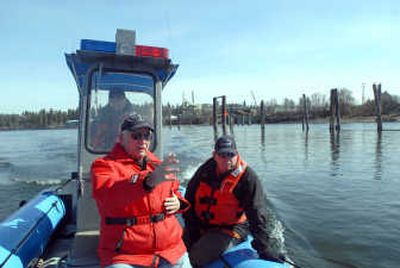Mills gone, concerns are piling up

As the last sawmill on the Spokane River prepares to close, discussion is under way on how to remove the pilings no longer needed to corral and guide the logs that once ruled the waterways.
The weathered and splintered remnants of the working waterfront have become hazards to boaters as the shoreline transitions from mills to condos, ritzy retail stores and restaurants.
Many of the larch and fir pilings have rotted off at the water line, meaning during summer high water they lurk just a foot under the surface and can eat boat props and tear out transmissions.
“I bump them every summer in the jet boat,” Kootenai County Sheriff Deputy Ryan Higgins said as he steered the boat in front of Cedars Floating Restaurant, where about 40 pilings peek out from the mouth of the river. In the summer these vertical logs, pounded into the riverbed decades ago, are submerged, making them even more dangerous, especially to boaters unfamiliar with the river and the maze of pilings.
The channel between the North Idaho College beach and U.S. Highway 95 Bridge would become about twice as wide if the pilings were removed along the stretch.
As the sawmills slowly disappeared, boat users have complained about the pilings, which run from the north end of Lake Coeur d’Alene downriver to the Post Falls dam. But little has been done.
Tired of the griping and inaction, Kootenai County Parks and Waterways Director Nick Snyder has called a public meeting Tuesday night to discuss a cooperative effort among government agencies, residents and businesses to develop a removal plan.
There’s some concern that removing the pilings will stir up heavy metals and sediment that could harm fish and water quality.
Jim Aucutt, chairman of the county Parks and Waterways Advisory Committee, thinks a barge could nudge each piling, breaking it off at the mud line. That method was used in 2003 to remove about 700 pilings that once corralled logs in front of the Crown Pacific mill. The developers of the Mill River housing development on the former mill site paid to remove the pilings so homeowners would have a cleaner view.
Kootenai County paid to have pilings on the south side of the river in that area removed.
The Idaho Department of Environmental Quality, state Fish and Game and Kootenai Environmental Alliance advocate sending divers down to cut the timbers loose. They fear using a barge to push or pull the pilings would create too much sediment disruption, especially by the propeller wash.
“Cutting seems to be the all-around best idea, especially when we have contaminated sediments,” said June Berquist, a DEQ water quality specialist.
Local residents and state agencies are perhaps extra cautious in the wake of the April 2007 destruction of kokanee salmon spawning beds during construction of a marina in Bayview on Lake Pend Oreille. Steel pilings were pounded through the spawning beds in the bay, and the propeller wash from a construction barge turned the area in a stew of mud and fish eggs.
There’s also controversy over businessman Duane Hagadone’s proposal to dredge the Blackwell Island Channel at the mouth of the Spokane River to allow for larger boats as part of an upgrade to the marina. Experts are testing the soil to determine whether it contains toxic heavy metals, such as lead.
“We’re going to listen to everybody and try to find middle ground and make it work,” said Mike Denney of the Idaho Department of Lands, the agency that has oversight of many of the pilings no longer leased by mills.
Besides deciding on a removal method, the big question that lingers is who will pay for the work to remove an estimated 1,000 pilings.
Aucutt estimates it could cost between $10 to $20 per piling.
“Everybody says this ought to be done but nobody wants to spend the money to do it,” he said.
As Aucutt pointed out the most hazardous pilings on the river, tug captain Oscar Mooney chugged by with the last bundle of logs to the DeArmond sawmill that will close in May.
“That’s the last bundle, the last bundle of logs down the lake,” Mooney yelled across the river to the sheriff’s boat, waving his hands in excitement.
“That right there is historic,” Deputy Tom Alexander said.